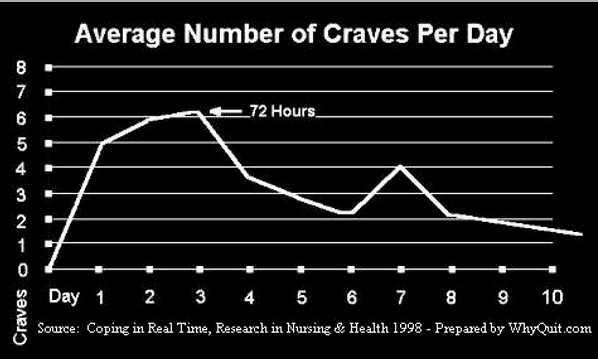How often do crave episodes occur after ending nicotine use? The best we can do in answering this question is to share study averages.
The obvious problem with averages is that we may not be average, which ranges from the 4 to 5 pack-a-day smoker to the habituated-only user, who may go days without using, who only experiences craving in the seconds prior to inhaling but not before.[1]
And let's not forget the new addict who, as yet, may have established few conditioned use cues.
A 1998 real-time crave coping study followed 36 participants who used tape recorders and palm computers to record details of 389 coping episodes during their first 10 days of smoking cessation.[2]

It found that the day on which the most crave episodes occurred was the third day of recovery, with an average of 6.1 craves. Day four's average dropped to 3.5, with day five generating just 3 craves per day. By day ten the average fell to just 1.4 episodes per day.
If each crave episode peaks in less than 5 minutes, and the average number on the most challenging day is 6.1, that's a total of 30 minutes of crave anxiety on your most challenging day of recovery.
Can you handle 30 minutes of significant challenge in order to reclaim your mind and take back your life? Absolutely! We all can.
But what if you're not average? What if you conditioned your subconscious to have twice as many cues as the average user? That would mean that you could experience a maximum of 60 minutes of total crave episode anxiety on your most challenging day.
Is there any doubt whatsoever that you handle 60 minutes of challenge in order to permanently reclaim the driver's seat of your mind? And you won't be asked to do it all at once. Just a few minutes and then take a break.
Prepare for the possibility of a small spike on day seven. While the average study participant was down to just over 2 episodes per day by day six, day seven brought an average of 4 cravings, before returning to 2 on day eight. Why? We can only guess.
And there are lots of theories. One is that life is measured in weeks and a full week of freedom provided the first significant reason for celebration. Did your subconscious associate use with celebration? If so, what about the celebration that turns sour, like when everyone but mom forgets our birthday? Could that generate a second episode?
Again, we're just guessing. What we do know is that every new ex-user is fully capable of handling a few minutes of challenge.
Looking at the study's chart, reflect on how the average newbie both moves beyond peak physical withdrawal within 72 hours and navigates the peak number of use cues. Coincidence?
While we have zero control over nicotine's elimination half-life, the recovery day on which we decide to fully engage life and confront the bulk of our normal daily use cues is very much within our control.
Joel always started his clinics on a Tuesday night. Historically, many programs encouraged users to start on the weekend, thinking that it will help avoid work pressures. If so, Monday brings day three, work, and the first full engagement of life.
References:
2. O'Connell KA, et al, Coping in real time: using Ecological Momentary Assessment techniques to assess coping with the urge to smoke, Research in Nursing and Health, December 1998, Volume 21(6), Pages 487-497.
All rights reserved
Published in the USA
